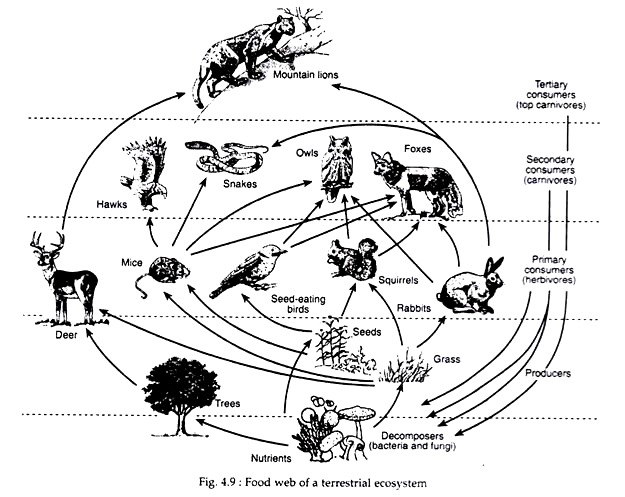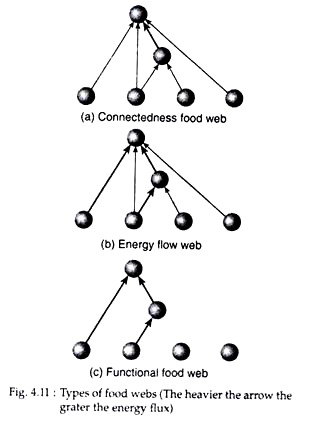In this article we will discuss about:- 1. Meaning of Food Web 2. Types of Food Web 3. Reward Feedbacks.
Meaning of Food Web:
Food chains are not isolated sequence, rather, they are interconnected. Most ecosystems contain a number of interconnected trophic interactions, which taken together are referred to as food web. A typical food web for a terrestrial ecosystem is given in Fig. 4.9. As can be seen, a number of food chains operate which ultimately end either at the tertiary consumer level (lion) or at the secondary consumer level (hawk or owl).
Another example of a food web for an aquatic ecosystem is given in Fig. 4.10.
Types of Food Web:
Three different concepts of food web (Fig. 4.11) has been observed by Paine (1980).
1. Connectedness food web:
They are also known as topological food web. Such food web emphasises feeding relationships among organisms, portrayed as links in the web. It depicts only the presence or absence of a trophic interaction. They, however, do not show the strength of the interaction, nor any change in trophic relationships (Fig. 4.11a). For the above reasons, topological food webs are sometimes referred to as static food web.
ADVERTISEMENTS:
2. Energy flow web:
It is sometimes referred to as flow web or as bio-energetic web. It represents an ecosystem viewpoint (Fig. 4.11b). Here connections between populations are quantified by the flux of energy between a resource and its consumer.
3. Functional food web:
ADVERTISEMENTS:
Also known as interaction food web that identify the feeding relationships within the topological food web that are most important to community structure (Fig. 4.11c). The above three food webs depict the importance of each population in maintaining the integrity of a community. Such interactions are the focus of dynamic food web studies.
Reward Feedbacks in Food Webs:
Food webs have been found to involve much more than “who eats whom” (predator prey relationship) — an effect known as reward feedback. It has been seen that a “downstream” organism has a positive effect on its “upstream” food supply in the sense that a consumer organism (herbivore) does something that sustains the survival of its food resource (plant).
For example, the fiddler crabs, which feed on surface algae and detritus in coastal marshes, “cultivate” their food plants in several ways. Similarly, vast herds of antelopes grazing on the plains increase the net production of grasses.
In other words, the annual vegetative growth is greater with the grazers than without them. So food webs exhibit partnerships and mutually beneficial relationships between producers and consumers and between different levels of consumers.
Concentration of toxic substances along food chain:
Sometimes certain toxic substances, instead of dispersing, gets concentrated at each link in the chain and are thus referred to as food chain concentration, or, in particular, biological magnification or bioaccumulation. These materials may be put into the environment dilute but may come back concentrated.
Two factors are involved. One, the material remains in the body of the organism and the other is the structure of food chains and trophic levels. An example of such a build-up can be illustrated in the case of DDT (dichlorodiphenyltrichloroethane), a contact insecticide used for the control of mosquitoes. DDT is soluble in fat but not in water.
This toxic insecticide get washed away in various water bodies and get absorbed on detritus. Consequently, when DDT is in or on the food eaten by the herbivore, it tends to be stored in the fat of the animal, rather than excreted or metabolised or denatured.
Subsequently, when these herbivores are eaten up by the carnivores, it results in increased concentration of the insecticide at each step in the food chain, until top predators suffer from very high doses. Prime examples are some of the large seabirds and hawks, where due to high pesticide level, reproductive abnormalities, thin egg shells etc. have been reported.
ADVERTISEMENTS:
Bio-magnification may even threaten the human food chain, especially when fishes are affected.
Besides DDT there are DDD (Fig. 4.12), vaclioisotopes and heavy metals like lead, mercury, copper etc. that exhibit bio-magnifications.



